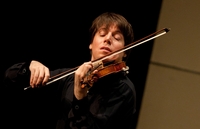Joshua Bell, Academy of St. Martin in the Fields make the most of all-Beethoven season finale

Joshua Bell publicity photo
photo b Eric Kabik
But almost any way you look at it, Sunday afternoon’s concert at Hill Auditorium was brimming with import. It was the last of the University Musical Society’s musical events for the 2011-2012 season. It was also the first time the audience got to see superstar violinist Joshua Bell in his new role as music director of the Academy of St. Martin in the Fields, an orchestra he’s long been associated with as a soloist.
And it was the day of the University Musical Society Ford Honors Gala, the day the UMS gives away its Distinguished Artist Award. But it wasn’t merely the award recipients—Bell and violinist Harvey de Souza, representing the orchestra he leads from the first violin desk when Bell’s not in that chair—who got to pose for photos. The audience—like one about century ago when the hall opened—was asked to say cheese as well. In other words, it was quite the occasion.
And the music-making, before a house packed to the rafters, lived up to the star billing. It’s early in Bell’s tenure with the orchestra—but it was great to see them together in the honeymoon phase of the relationship. The mutual admiration was palpable between players and leader.
Sunday afternoon, that affection translated into vivid performances, filled with a sense of dialogue among the instruments, whether Bell led from within the orchestra or from the soloist’s spot.
Bell’s playing, sweet and sublimely focused, reached empyrean heights in the violin concerto, which emphasized colloquy over confrontation. For drama in the concerto, one could enjoy Bell’s Janus-like transformations: now he was conductor, facing the orchestra, leading with his hand or bow; now, wheeling about, he was soloist, facing us, making music with his violin as de Souza took over leadership duties from his chair. It was tough act, but one Bell executed with grace and poise—and no loss on either score.
There was no lack of musical drama, however, in the “Coriolan.” From the first vehement chords, it was manifest, contrasting with the lyrical interludes played with aching spaciousness. The ensemble was impeccable, and the playing was warm, as it was throughout the afternoon.
The playing went from warm to super-heated in the closing Symphony No. 7 in A Major, Op. 92. The St. Martin players, with Bell in the lead, took the “con brio” instruction of the last movement quite to heart—it was music to get the blood going. But the orchestra had much to say about pacing throughout the work, taking time to mark time, in little oases of stasis, before taking off again, and plumbing the depths of the soulfull second-movement allegretto. And if the strings, taking a cue from Bell, played like Gods, so did the brass and winds—the colors were glorious and glowing, and, in the case of the brass, unretiring in a most becoming way.

